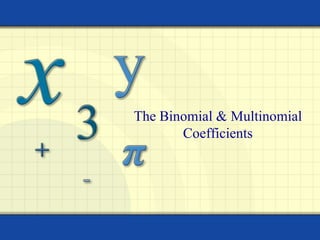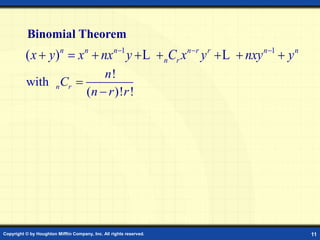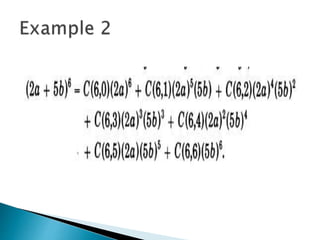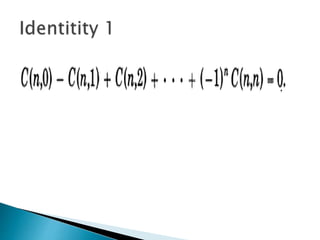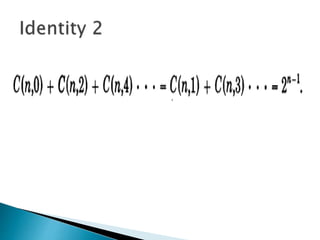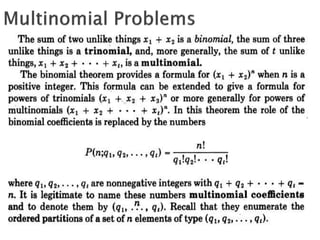Binomial
- 1. The Binomial & Multinomial Coefficients
- 2. ? In formulas arising from the analysis of algorithms in computer science, the binomial coefficients occur over and over again, so that a facility for manipulating them is a necessity. ? Moreover, different approaches to problems often give rise to formulas that are different in appearance yet identities of binomial coefficients reveal that they are, in fact, the same expressions.
- 3. Copyright ? by Houghton Mifflin Company, Inc. All rights reserved. 3 The binomial theorem provides a useful method for raising any binomial to a nonnegative integral power. Consider the patterns formed by expanding (x + y)n. (x + y)0 = 1 (x + y)1 = x + y (x + y)2 = x2 + 2xy + y2 (x + y)3 = x3 + 3x2y + 3xy2 + y3 (x + y)4 = x4 + 4x3y + 6x2y2 + 4xy3 + y4 (x + y)5 = x5 + 5x4y + 10x3y2 + 10x2y3 + 5xy4 + y5 Notice that each expansion has n + 1 terms. 1 term 2 terms 3 terms 4 terms 5 terms 6 terms Example: (x + y)10 will have 10 + 1, or 11 terms.
- 4. Copyright ? by Houghton Mifflin Company, Inc. All rights reserved. 4 Consider the patterns formed by expanding (x + y)n. (x + y)0 = 1 (x + y)1 = x + y (x + y)2 = x2 + 2xy + y2 (x + y)3 = x3 + 3x2y + 3xy2 + y3 (x + y)4 = x4 + 4x3y + 6x2y2 + 4xy3 + y4 (x + y)5 = x5 + 5x4y + 10x3y2 + 10x2y3 + 5xy4 + y5 1. The exponents on x decrease from n to 0. The exponents on y increase from 0 to n. 2. Each term is of degree n. Example: The 5th term of (x + y)10 is a term with x6y4.Ąą
- 5. Copyright ? by Houghton Mifflin Company, Inc. All rights reserved. 5 The coefficients of the binomial expansion are called binomial coefficients. The coefficients have symmetry. The coefficient of xnĻCryr in the expansion of (x + y)n is written or nCr . n r ? ? ? ? ? ? (x + y)5 = x5 + 5x4y + 10x3y2 + 10x2y3 + 5xy4 + y5 The first and last coefficients are 1. The coefficients of the second and second to last terms are equal to n. 1 1 Example: What are the last 2 terms of (x + y)10 ? Since n = 10, the last two terms are 10xy9 + 1y10. So, the last two terms of (x + y)10 can be expressed as 10C9 xy9 + 10C10 y10 or as xy9 + y10. ?? ? ? ?? ? ? 9 10 ?? ? ? ?? ? ? 10 10
- 6. Copyright ? by Houghton Mifflin Company, Inc. All rights reserved. 6 The triangular arrangement of numbers below is called PascalĄŊs Triangle. Each number in the interior of the triangle is the sum of the two numbers immediately above it. The numbers in the nth row of PascalĄŊs Triangle are the binomial coefficients for (x + y)n . 1 1 1st row 1 2 1 2nd row 1 3 3 1 3rd row 1 4 6 4 1 4th row 1 5 10 10 5 1 5th row 0th row1 6 + 4 = 10 1 + 2 = 3
- 7. Copyright ? by Houghton Mifflin Company, Inc. All rights reserved. 7 Example: Use the fifth row of PascalĄŊs Triangle to generate the sixth row and find the binomial coefficients , , 6C4 and 6C2 . 6 1 ? ? ? ? ? ? 6 5 ? ? ? ? ? ? 5th row 1 5 10 10 5 1 6th row 6 0 ? ? ? ? ? ? 6 1 ? ? ? ? ? ? 6 2 ? ? ? ? ? ? 6 3 ? ? ? ? ? ? 6 4 ? ? ? ? ? ? 6 5 ? ? ? ? ? ? 6 6 ? ? ? ? ? ? 6C0 6C1 6C2 6C3 6C4 6C5 6C6 = 6 = and 6C4 = 15 = 6C2. 6 1 ? ? ? ? ? ? 6 5 ? ? ? ? ? ? There is symmetry between binomial coefficients. nCr = nCnĻCr 1 6 15 20 15 6 1
- 8. Copyright ? by Houghton Mifflin Company, Inc. All rights reserved. 8 Example: Use PascalĄŊs Triangle to expand (2a + b)4. (2a + b)4 = 1(2a)4 + 4(2a)3b + 6(2a)2b2 + 4(2a)b3 + 1b4 = 1(16a4) + 4(8a3)b + 6(4a2b2) + 4(2a)b3 + b4 = 16a4 + 32a3b + 24a2b2 + 8ab3 + b4 1 1 1st row 1 2 1 2nd row 1 3 3 1 3rd row 1 4 6 4 1 4th row 0th row1
- 9. Copyright ? by Houghton Mifflin Company, Inc. All rights reserved. 9 The symbol n! (n factorial) denotes the product of the first n positive integers. 0! is defined to be 1. n! = n(n ĻC 1)(n ĻC 2) ? 3 ? 2 ? 1 1! = 1 4! = 4 ? 3 ? 2 ? 1 = 24 6! = 6 ? 5 ? 4 ? 3 ? 2 ? 1 = 720 Formula for Binomial Coefficients For all nonnegative integers n and r, ! ( )! ! n r n C n r r ? ? Example: )123()1234( )123()4567( ?????? ?????? ? !3!4 7 !3!4 !7 !3)!37( !7 ??? 37 ?? ? ?C 35 1234 4567 ??? ??? ??
- 10. Copyright ? by Houghton Mifflin Company, Inc. All rights reserved. 10 Example: Use the formula to calculate the binomial coefficients 10C5, 10C0, and .50 48 ? ? ? ? ? ? 12 1 ? ? ? ? ? ? !5)!510( !10 ? 510 ? ?C !0)!010( !10 ? 010 ? ?C !48)!4850( !50 48 50 ?? ??? ? ? ?? ? ? !1)!112( !12 1 12 ?? ??? ? ? ?? ? ? !5!5 !10 ? ? !5!5 !5)678910( ? ????? ? 252 12345 678910 ???? ???? ?? !0!10 !10 ? ? 1 1 1 !0 !1 ??? !48!2 !48)4950( !48!2 !50 ? ?? ? ?? 1225 12 4950 ? ? ?? !1!11 !1112 !1!1 !12 ? ? ? ?? 12 1 12 ??
- 11. Copyright ? by Houghton Mifflin Company, Inc. All rights reserved. 11 Binomial Theorem 1 1 ( )n n n n r r n n n rx y x nx y C x y nxy y? ? ? ? ? ? ? ? ? ? ?L L ! with ( )! ! n r n C n r r ? ?
- 13. Copyright ? by Houghton Mifflin Company, Inc. All rights reserved. 13 Binomial Theorem Example: Use the Binomial Theorem to expand (x4 + 2)3. 03C 13C 23C 33C?? 34 )2(x ?34 )(x ?)2()( 24 x ?24 )2)((x 3 )2( 1 ?34 )(x? 3 ?)2()( 24 x 3 ?24 )2)((x 1 3 )2( 8126 4812 ???? xxx
- 14. Copyright ? by Houghton Mifflin Company, Inc. All rights reserved. 14 Although the Binomial Theorem is stated for a binomial which is a sum of terms, it can also be used to expand a difference of terms. Simply rewrite (x + y)n as (x + (ĻC y))n and apply the theorem to this sum. Example: Use the Binomial Theorem to expand (3x ĻC 4)4. 4 )43( ?x 4 ))4(3( ??? x 432234 )4(1)4)(3(4)4()3(6)4()3(4)3(1 ????????? xxxx 256)64)(3(4)16)(9(6)4)(27(481 234 ??????? xxxx 25676886443281 234 ????? xxxx
- 15. Copyright ? by Houghton Mifflin Company, Inc. All rights reserved. 15 Example: Use the Binomial Theorem to write the first three terms in the expansion of (2a + b)12 . ...)2( 2 12 )2( 1 12 )2( 0 12 )2( 210111212 ??? ? ? ?? ? ? ??? ? ? ?? ? ? ??? ? ? ?? ? ? ?? babaaba ...)2( !2)!212( !12 )2( !1)!112( !12 )2( !0)!012( !12 2101011111212 ??? ? ? ? ? ? ? ? babaa ...)2)(1112()2(12)2( 2101011111212 ? ???? babaa ...135168245764096 2101112 ???? babaa
- 16. Copyright ? by Houghton Mifflin Company, Inc. All rights reserved. 16 Example: Find the eighth term in the expansion of (x + y)13 . Think of the first term of the expansion as x13y0 . The power of y is 1 less than the number of the term in the expansion. The eighth term is 13C7 x6y7. Therefore, the eighth term of (x + y)13 is 1716 x6y7. !7!6 !7)8910111213( !7!6 !13 ? ?????? ? 713 ??C 1716 123456 8910111213 ????? ????? ??
- 17. Find the 6th term in the expansion of (3a + 2b)12 Using the Binomial Theorem, let x = 3a and y = 2b and note that in the 6th term, the exponent of y is m = 5 and the exponent of x is n ĻC m = 12 ĻC 5 = 7. Consequently, the 6th term of the expansion is: ?57 512 yxC ? ? ? ?57 23 !5!7 !789101112 ba ? ????? = 55,427,328 a7b5
- 18. E.g. 7ĄŠFinding a Particular Term in a Bin. Expansion Find the coefficient of x8 in the expansion of ? Both x2 and 1/x are powers of x. ? So, the power of x in each term of the expansion is determined by both terms of the binomial. 10 2 1 x x ? ? ?? ? ? ?
- 19. To find the required coefficient, we first find the general term in the expansion. ? By the formula, we have: a = x2, b = 1/x, n = 10 ? So, the general term is: E.g. 7ĄŠFinding a Particular Term in a Bin. Expansion 10 2 2 1 10 3 10 10 101 ( ) ( ) 10 10 10 10 r r r r r x x x r x r x r ? ? ? ? ? ? ? ?? ? ?? ? ? ?? ?? ?? ?? ? ? ? ? ? ? ? ? ?? ?
- 20. Thus, the term that contains x8 is the term in which 3r ĻC 10 = 8 r = 6 ? So, the required coefficient is: E.g. 7ĄŠFinding a Particular Term in a Bin. Expansion 10 10 210 10 6 4 ? ? ? ? ? ?? ? ? ? ?? ? ? ?

